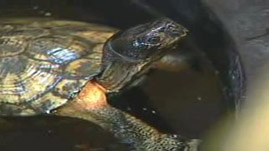Turtles are similar to us: They can live more than 100 years, they eat a diet of vegetables, fruits, and animal protein, and they like to swim!
Turtle species have identifiable characteristics. The wood turtle featured in the video spends half of his time in the water and half on land, swimming around, digging in the wood chips, or climbing around on rocks. His legs function both in water and on land, and are bright red or orange; they are the reason for his nickname “Old Red Legs.” The Eastern box turtle has a shell the color of tree leaves that help it hide in the leaf litter on the forest floor. Female box turtles have brown eyes, while the eyes of males are red. A box turtle can live up to 120 years!
When a characteristic such as a camouflage shell helps an organism to survive, it is called an adaptation. Adaptations develop over time or are passed down through generations; they can be structural or behavioral.
A structural adaptation is physical, and helps an organism move or eat. The wood turtle’s legs have adapted to help it move both in water and on land. A behavioral adaptation is how an organism acts or responds to stimuli in its environment. Some examples of behavioral adaptations include when a turtle retracts its body into its shell for protection, or when it remains still, so predators can’t detect it.
Shaver's Creek Environmental Center has created an artificial habitat featured in the video based upon a thorough understanding of turtle physiology and behavior. The indoor habitat provides turtles with everything they need. They eat a diet of vegetables, fruits, and animal proteins twice a week. They prefer overripe fruit, and red colored foods. They can also pick and choose from slugs and worms, or browse through other food gathered from the wild, like mushrooms, berries, and greens.
In addition to a nutritious diet, the artificial habitat at Shaver’s Creek provides light, water, and shelter for the turtles that mimic the wild. Because of the complexity of their needs, turtles make difficult pets and are best left outdoors to admire. The turtles at the center are kept there because they have sustained injuries that prevent them from surviving in the wild.
To learn more about the family of turtles, check out Turtle Defense and Desert Tortoise.
To learn more about camouflage, check out the praying mantis in the Evolution of Camouflage and how spineless creatures defend themselves in Masters of Disguise.
To learn more about instinctive behaviors, check out the migration of butterflies on an epic scale in Monarch Migration.

